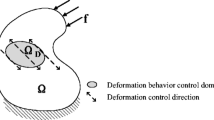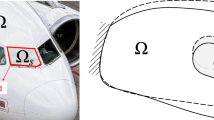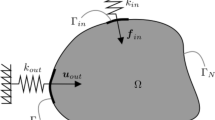Abstract
The purpose of this paper is to demonstrate a shape preserving topology optimization design approach to suppress the warping deformation of local structural domains. As structural deformation consists of rigid body motion and warping deformation, we propose using the elastic strain energy of the local domain to measure the warping deformation. Constraint on the local strain energy is then introduced into a standard compliance based topology optimization to obtain the shape preserving effect. Moreover, in the cases of shape preserving for multiple key points and cavities, i.e. when the local strain energies are unavailable, the idea of Artificial Weak Element (AWE) is introduced to measure and constrain the local warping deformation. Several numerical examples are tested here. The optimized results indicate that the local strain energy constraints on the shape preserving domains can suppress the warping deformation effectively in both simple illustrative examples and complicated engineering examples. Further discussions on the failure of structural load carrying path and the influence of the shape preserving constraint is also presented.























Similar content being viewed by others
References
Barrett RT (1992) Fastener design manual. NASA Reference Publication 1228
Bendsøe MP (1989) Optimal shape design as a material distribution problem. Struct Optim 1:193–202
Clausen A, Aage N, Sigmund O (2014) Topology optimization with flexible void area. Struct Multidiscip Optim 50:927–943
Deaton J, Grandhi R (2014) A survey of structural and multidisciplinary continuum topology optimization: post 2000. Struct Multidiscip Optim 49:1–38. doi:10.1007/s00158-013-0956-z
Grihon S, Krog L, Bassir D (2009) Numerical optimization applied to structure sizing at AIRBUS: a multi-step process. Int J Simul Multidiscip Des Optim 3:432–442
Guest JK (2011) A projection-based topology optimization approach to distributing discrete features in structures and materials. 9th World Congress on Structural and Multidisciplinary Optimization, Shizuoka, Japan, June, pp 13–17
Guest JK (2015) Optimizing the layout of discrete objects in structures and materials: a projection-based topology optimization approach. Comput Methods Appl Mech Eng 283:330–351
Guo X, Cheng GD (2010) Recent development in structural design and optimization. Acta Mech Sin 26:807–823. doi:10.1007/s10409-010-0395-7
Ha SH, Guest JK (2014) Optimizing inclusion shapes and patterns in periodic materials using Discrete Object Projection. Struct Multidiscip Optim 50:65–80
Huang X, Xie YM (2009) Evolutionary topology optimization of continuum structures with an additional displacement constraint. Struct Multidiscip Optim 40:409–416. doi:10.1007/s00158-009-0382-4
Huff J (2002) Improving the service life of flight deck windshields. Boeing Aero Mag 17:3–9
Kim SI, Kim YY (2014) Topology optimization of planar linkage mechanisms. Int J Numer Methods Eng 98:265–286
Krog L, Tucker A, Rollema G (2002) Application of topology, sizing and shape optimization methods to optimal design of aircraft components. Proc. 3rd Altair UK HyperWorks Users Conf
Li Q, Steven GP, Xie YM (1999) Displacement minimization of thermoelastic structures by evolutionary thickness design. Comput Methods Appl Mech Eng 179:361–378
Lin HY, Rayasam M, Subbarayan G (2014) ISOCOMP: Unified geometric and material composition for optimal topology design. Struct Multidiscip Optim 51:687–703
Maute K, Allen M (2004) Conceptual design of aeroelastic structures by topology optimization. Struct Multidiscip Optim 27:27–42
Nam SJ, Jang GW, Kim YY (2012) The spring-connected rigid block model based automatic synthesis of planar linkage mechanisms: numerical issues and remedies. J Mech Des 134:051002
Niu MCY (1988) Airframe structural design: practical design information and data on aircraft structures. Technical Book Co
Pedersen CB, Buhl T, Sigmund O (2001) Topology synthesis of large displacement compliant mechanisms. Int J Numer Methods Eng 50:2683–2705
Qian Z, Ananthasuresh GK (2004) Optimal embedding of rigid objects in the topology design of structures. Mech Based Des Struct Mach 32:165–193
Qiao HT, Liu ST (2013) Topology optimization by minimizing the geometric average displacement. Eng Optim 45:1–18
Radovcic Y, Remouchamps A (2002) BOSS Quattro: an open system for parametric design. Struct Multidiscip Optim 23:140–152
Remouchamps A, Bruyneel M, Fleury C, Grihon S (2011) Application of a bi-level scheme including topology optimization to the design of an aircraft pylon. Struct Multidiscip Optim 44:739–750
Sigmund O (1997) On the design of compliant mechanisms using topology optimization. Mech Struct Mach 25:493–524
Sigmund O (2001) A 99 line topology optimization code written in Matlab. Struct Multidiscip Optim 21:120–127
Sigmund O (2007) Morphology-based black and white filters for topology optimization. Struct Multidiscip Optim 33:401–424
Sigmund O, Maute K (2013) Topology optimization approaches. Struct Multidiscip Optim 48:1031–1055
Sigmund O, Petersson J (1998) Numerical instabilities in topology optimization: a survey on procedures dealing with checkerboards, mesh-dependencies and local minima. Struct Optimization 16:68–75
Stanford B, Beran P (2012) Optimal compliant flapping mechanism topologies with multiple load cases. J Mech Des 134:51007
Stanford B, Beran P, Kobayashi M (2013) Simultaneous topology optimization of membrane wings and their compliant flapping mechanisms. AIAA J 51:1431–1441
Svanberg K (2007) On a globally convergent version of MMA. 7th World Congress on Structural and Multidisciplinary Optimization. COEX Seoul , Korea
Wang BZ (2000) Aircraft design manual 10: structural design. Aviation Industry Press, Beijing
Wang MY, Chen S, Wang X, Mei Y (2005) Design of multimaterial compliant mechanisms using level-set methods. J Mech Des 127:941–956
Xie YM, Steven GP (1993) A simple evolutionary procedure for structural optimization. Comput Struct 49:885–896. doi:10.1016/0045-7949(93)90035-C
Zhou M, Rozvany GIN (1991) The COC algorithm, part II: topo- logical, geometry and generalized shape optimization. Comput Methods Appl Mech Eng 89(1–3):309–336
Zhu JH, Zhang WH, Beckers P (2009) Integrated layout design of multi-component system. Int J Numer Methods Eng 78:631–651
Zhu JH, Li Y, Zhang WH (2014) Topology optimization with shape preserving design. the 5th International Conference on Computational Methods. 2014 28-30th July. Cambridge, England
Zhu JH, Zhang WH, Xia L (2015) Topology optimization in aircraft and aerospace structures design. Arch Comput Methods Eng. doi:10.1007/s11831-015-9151-2
Zuo ZH, Xie YM (2014) Evolutionary topology optimization of continuum structures with a global displacement control. Comput Des 56:58–67. doi:10.1016/j.cad.2014.06.007
Acknowledgments
This work is supported by National Natural Science Foundation of China (90916027, 51275424, 11172236), the 111 Project (B07050), Science and Technology Research and development projects in Shaanxi Province (2014KJXX-37), the Fundamental Research Funds for the Central Universities (3102014JC02020505).
Author information
Authors and Affiliations
Corresponding author
Rights and permissions
About this article
Cite this article
Zhu, JH., Li, Y., Zhang, WH. et al. Shape preserving design with structural topology optimization. Struct Multidisc Optim 53, 893–906 (2016). https://doi.org/10.1007/s00158-015-1364-3
Received:
Revised:
Accepted:
Published:
Issue Date:
DOI: https://doi.org/10.1007/s00158-015-1364-3




